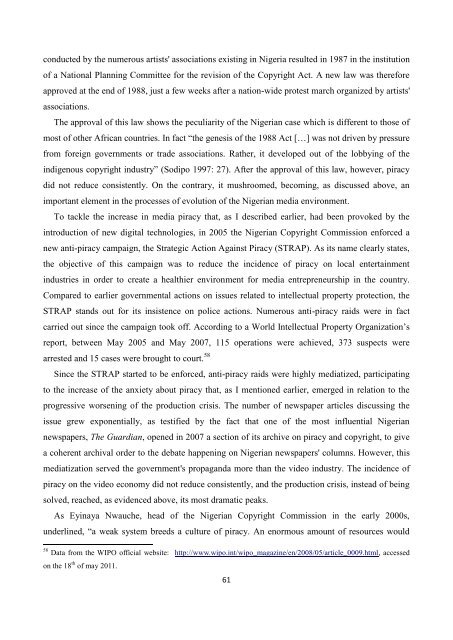Create successful ePaper yourself
Turn your PDF publications into a flip-book with our unique Google optimized e-Paper software.
conducted by the numerous artists' associations existing in Nigeria resulted in 1987 in the institutionof a National Planning Committee for the revision of the Copyright Act. A new law was thereforeapproved at the end of 1988, just a few weeks after a nation-wide protest march organized by artists'associations.The approval of this law shows the peculiarity of the Nigerian case which is different to those ofmost of other African countries. In fact “the genesis of the 1988 Act […] was not driven by pressurefrom foreign governments or trade associations. Rather, it developed out of the lobbying of theindigenous copyright industry” (Sodipo 1997: 27). After the approval of this law, however, piracydid not reduce consistently. On the contrary, it mushroomed, becoming, as discussed above, animportant element in the processes of evolution of the Nigerian media environment.To tackle the increase in media piracy that, as I described earlier, had been provoked by theintroduction of new digital technologies, in 2005 the Nigerian Copyright Commission enforced anew anti-piracy campaign, the Strategic Action Against Piracy (STRAP). As its name clearly states,the objective of this campaign was to reduce the incidence of piracy on local entertainmentindustries in order to create a healthier environment for media entrepreneurship in the country.Compared to earlier governmental actions on issues related to intellectual property protection, theSTRAP stands out for its insistence on police actions. Numerous anti-piracy raids were in factcarried out since the campaign took off. According to a World Intellectual Property Organization’sreport, between May 2005 and May 2007, 115 operations were achieved, 373 suspects werearrested and 15 cases were brought to court. 58Since the STRAP started to be enforced, anti-piracy raids were highly mediatized, participatingto the increase of the anxiety about piracy that, as I mentioned earlier, emerged in relation to theprogressive worsening of the production crisis. The number of newspaper articles discussing theissue grew exponentially, as testified by the fact that one of the most influential Nigeriannewspapers, The Guardian, opened in 2007 a section of its archive on piracy and copyright, to givea coherent archival order to the debate happening on Nigerian newspapers' columns. However, thismediatization served the government's propaganda more than the video industry. The incidence ofpiracy on the video economy did not reduce consistently, and the production crisis, instead of beingsolved, reached, as evidenced above, its most dramatic peaks.As Eyinaya Nwauche, head of the Nigerian Copyright Commission in the early 2000s,underlined, “a weak system breeds a culture of piracy. An enormous amount of resources would58 Data from the WIPO official website: http://www.wipo.int/wipo_magazine/en/2008/05/article_0009.html, accessedon the 18 th of may 2011.61
















